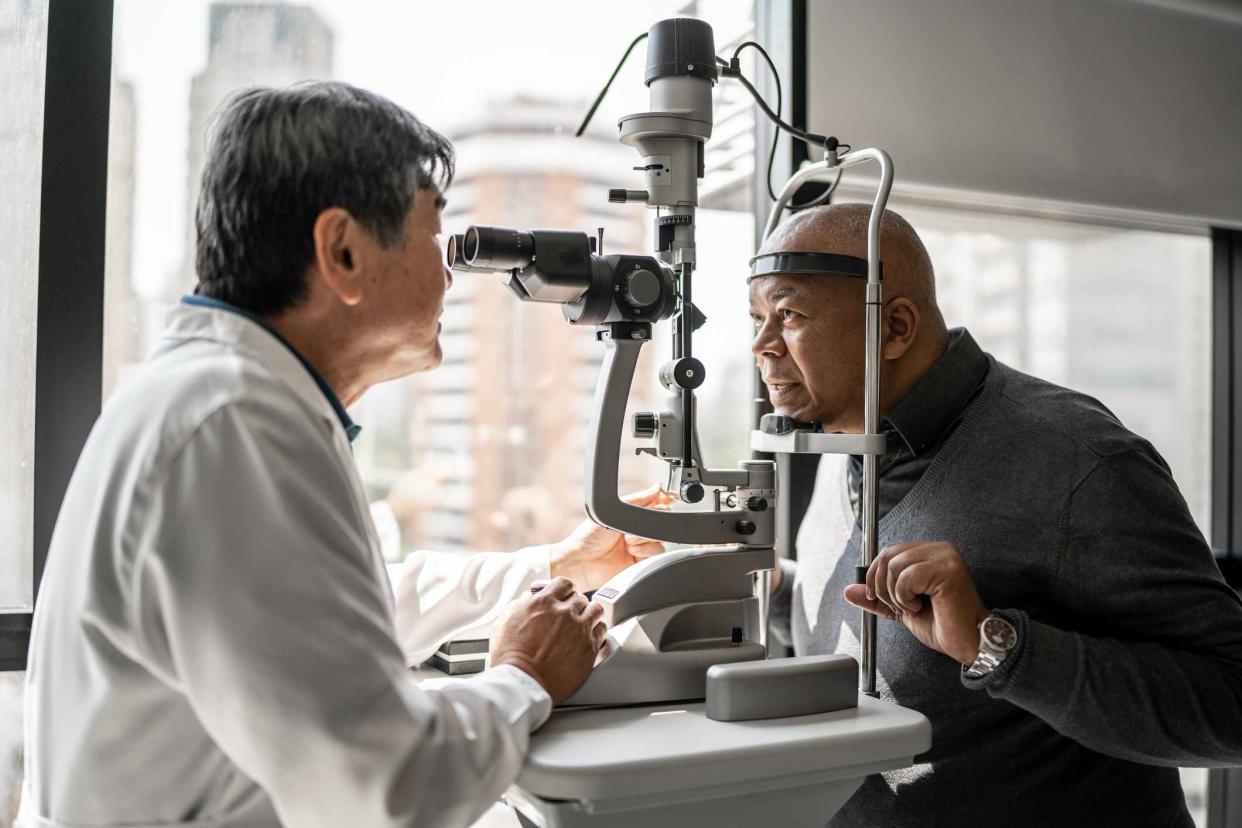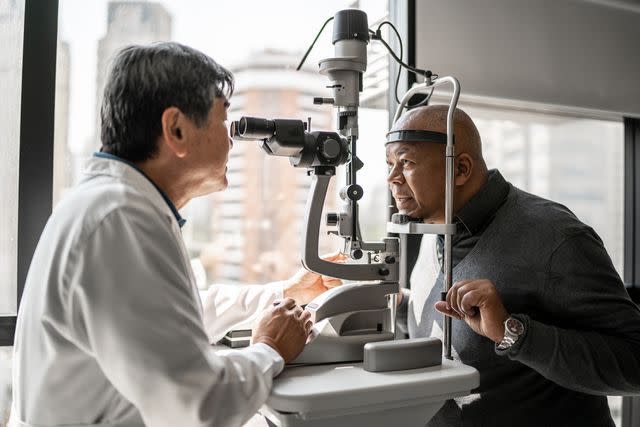1 in 4 People With Diabetes Have This Sight-Threatening Condition, Study Finds

FG Trade/Getty Images
Fact checked by Nick Blackmer
Nearly 10 million people with diabetes in the U.S. have diabetic retinopathy, or eye damage as a result from the disease, new research shows.
This is far greater than the previous estimate in 2004, which found 4.1 million people were living with the eye disease.
Untreated or poorly controlled diabetes is the primary reason people develop diabetic retinopathy, but a lack of screening and regular eye exams also plays a role.

FG Trade/Getty Images
Diabetes is a common condition that impacts more than 11% of the U.S. population, or 37.3 million people. The condition causes blood sugar to spike, which can result in numerous complications—including the development of diabetic retinopathy, a leading cause of blindness in adults.
“Diabetic retinopathy is a disease of the retina, which is the nerve layer in the back of the eye,” Mitul Mehta, MD, an ophthalmologist and associate clinical professor at the Gavin Herbert Eye Institute, University of California-Irvine, told Health. “This is primarily a disease of blood vessels because diabetes damages the blood vessels in the eye and all of these living tissues need working blood vessels to function.”
The risk for diabetic retinopathy is much more significant than originally thought, according to a study published June 15 in the journal JAMA Ophthalmology.
Using data from the Centers for Disease Control and Prevention’s (CDC) Vision and Eye Health Surveillance System and data from the U.S. Census Bureau, the scientists estimated that in 2021, approximately 9.6 million people (or 26.43% of people with diabetes) had diabetic retinopathy. The researchers found that 1.84 million people, or about 5% of people with diabetes, had vision-threatening forms of diabetic retinopathy.
This compares to the previous estimate—from 2004—that found that 4.1 million people were living with diabetic retinopathy and 899,000 people had vision-threatening diabetic retinopathy.
Untreated or poorly controlled diabetes is the primary reason people develop diabetic retinopathy, Ronald L. Benner, OD, an optometrist and president of the American Optometry Association, told Health. But, a lack of screening and regular eye exams also plays a role.
Here is what you need to know about diabetes and vision.
How Diabetes Affects Vision
The amount and type of diabetes-related vision damage can vary widely, said Dr. Mehta. “It can cause everything from no damage to complete blindness with a painful eye that needs to be removed and everything in between,” he said.
Diabetes can also cause eye diseases aside from diabetic retinopathy, the most common diabetes-related eye condition. People can have macular edema (swelling in part of the retina), vitreous hemorrhage (bleeding in the eye), neovascular glaucoma (a very serious and hard to treat version of glaucoma), and cataracts (clouding on the lens of the eye), said Dr. Mehta.
“Sometimes if the diabetes is not adequately treated for a long time it can even cause a tractional retinal detachment and death of the retina,” he said.
These eye diseases occur when high levels of sugar (or glucose) in the blood damage or create blockages in the tiny blood vessels in the back of your eyes that go to the retina, Krista Gonzales, MD, an endocrinologist and educator at Pritikin Longevity Center in Miami, told Health. This triggers a series of events that can lead to eye damage.
“Your body tries to compensate for these blocked blood vessels by growing new blood vessels (neovascularization) that do not work as well as the original vessels,” said Dr. Gonzales. “These new blood vessels can leak or bleed more easily.”
Related: How Does Diabetes Affect Your Body?
What Is Diabetic Retinopathy?
Diabetic retinopathy can develop in patients with type 1 diabetes and type 2 diabetes and will cause vision loss without prompt diagnosis and treatment, Michael Abramoff, MD, PhD, an ophthalmologist, University of Iowa professor, and founder of Digital Diagnostics, told Health.
“Diabetic retinopathy is a progressive disease that will advance over time” Dr. Abramoff said. “In the most severe stages, the retina can tear loose or hemorrhage, causing irreversible vision loss.”
Typically, he added, visual symptoms are a late sign of diabetic retinopathy. “In fact, the disease can develop without noticeable symptoms, though damage can still occur to the neural cells in the retina, such as leaking blood vessels, swelling of the retina, and vessels hemorrhaging into the retina.”
Before symptoms like blurry vision or floaters develop, early diagnosis is critical because healthcare providers can treat the condition with good outcomes before it advances to the point in which successful treatment is almost impossible, Dr. Abramoff said.
“The annual eye exam for diabetes is key because it allows the disease to be discovered at the stage where treatment will be most successful,” he added. “However, some studies show that as low as only 15% of people with diabetes get their annual eye exams in some areas. As more people are diagnosed with diabetes, it will be even more important to prioritize new solutions for patients to get their annual eye exams for diabetes.”
Types of Diabetic Retinopathy
One type of diabetic retinopathy—called non-proliferative diabetic retinopathy (NPDR)—is the early stage of the disease in which symptoms will be mild or nonexistent, said Benner.
“In NPDR, the blood vessels in the retina are weakened,” he said. “Tiny bulges in the blood vessels, called micro-aneurysms, may leak fluid into the retina. This leakage may lead to swelling of the macula.”
The other type, proliferative diabetic retinopathy (PDR), refers to the more advanced form of the disease. “At this stage, circulation problems deprive the retina of oxygen,” Benner explained. “As a result, new, fragile blood vessels can begin to grow in the retina and into the vitreous, gel-like fluid that fills the back of the eye. The new blood vessels may leak blood into the vitreous, clouding vision.”
New blood vessels also grow into the area that drains fluid from the eye, said Benner. This increases pressure on the eye that can damage the optic nerve, which is responsible for sending visual information to the brain. “If left untreated, PDR can cause severe vision loss and even blindness,” said Benner.
Diagnosis and Treatment
Diabetic retinopathy can be diagnosed with a dilated fundus (retinal) exam. “We examine the retina and take several types of imaging studies like an OCT scan (optical coherence tomography) and sometimes a fluorescein angiogram, which is an injection of a plant-based dye into the veins of the arm, [that involves] taking special photos every few seconds to watch the blood flow into the retina,” Dr. Mehta said.
Autonomous AI (artificial intelligence), a system in which a computer can take images of the eye, is a newer way to diagnose diabetic retinopathy, according to Dr. Abramoff.
If you have diabetic retinopathy, you will need an annual screening to monitor the disease’s progression, said Dr. Mehta.
If caught early, ophthalmologists and retina specialists can treat diabetic retinopathy before irreversible visual loss or blindness occurs, said Dr. Abramoff. “Treatments include implants or injections of various drugs into the eye, laser surgery, and vitrectomy surgery for the more advanced stages.”
Related: A New AMA Statement Urges Doctors to Avoid Relying on BMI—Here's Why
How to Prevent Eye Damage From Diabetes
Dr. Gonzales pointed to preventative care as a key way to combat rising rates of diabetes and, consequently, diabetic retinopathy. “Improving healthcare disparities, ensuring patients with diabetes are getting proper screening, early intervention, and optimizing management of the disease can all help prevent the rates of increase of diabetic retinopathy,” said Dr. Gonzales.
Dr. Abramoff said one way to do all of those things is through wider adoption of Food and Drug Administration (FDA)-cleared autonomous AI, which can screen patients at a primary care doctor’s office so they don’t have to see a specialist. The tool has the potential to greatly improve patient access and help address health disparities, he said. “More people with diabetes can get tested for diabetic retinopathy before symptoms occur, avoiding visual loss and blindness.”
The American Diabetes Association recommends that people with diabetes have an eye examination at least once a year. People older than 40 who haven't been diagnosed with diabetes should go every two to four years until age 54, and then every one to two or three years, according to the American Academy of Ophthalmology.
“Early detection and treatment can limit the potential for significant vision loss from diabetic retinopathy,” echoed Benner. “You can find a local doctor of optometry on the AOA website.”
For more Health news, make sure to sign up for our newsletter!
Read the original article on Health.

